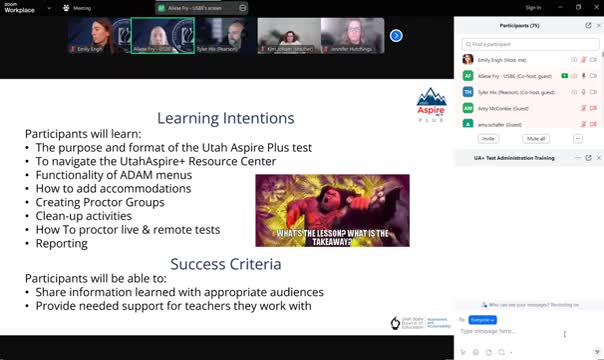Utah launches new Aspire Plus assessment for 9th and 10th graders testing this spring
January 31, 2025 | Utah State Board of Education, Utah Government Divisions, Utah Legislative Branch, Utah
This article was created by AI summarizing key points discussed. AI makes mistakes, so for full details and context, please refer to the video of the full meeting. Please report any errors so we can fix them. Report an error »

On January 31, 2025, a government meeting in Utah focused on the upcoming administration of the Utah Aspire Plus assessment, set to take place from March 3 to May 9, 2025. This meeting aimed to provide guidance to Local Education Agencies (LEAs) on the assessment process, ensuring that teachers and administrators are well-prepared for the testing period.
The Utah Aspire Plus assessment is designed for 9th and 10th graders and serves as an end-of-grade level evaluation. It consists of three subtests covering reading, math, and science, utilizing a hybrid format that includes both ACT Aspire and Utah test bank items. Notably, the English component has been removed for the 2025 administration due to changes in educational standards, resulting in a total test time reduction of 45 minutes.
LEAs have the flexibility to determine their own testing schedules, with the option to administer the assessment in one sitting or on a subject-by-subject basis. However, once a subject test begins, it must be completed in that session. The meeting emphasized the importance of appropriate testing environments, particularly for students requiring accommodations, to minimize disruptions during the assessment.
Additionally, the meeting outlined the roles within the ADAM (Assessment Data Management) system, which is crucial for managing user accounts and data access related to the assessment. The district administrator role is pivotal, as it is responsible for creating user accounts and overseeing data for their respective LEAs. Other roles include district-level users and school administrators, each with specific permissions and responsibilities.
The meeting also clarified that proctors for the Utah Aspire Plus assessment do not need to log into the ADAM system, simplifying the administration process. However, it is essential that all proctors, including retired faculty and substitute teachers, receive proper training to ensure compliance with testing ethics.
In conclusion, the discussions during the meeting highlighted the critical preparations for the Utah Aspire Plus assessment, emphasizing the need for effective communication and training among educators. As the testing window approaches, LEAs are encouraged to utilize available resources and support from Pearson and the Utah State Board of Education to facilitate a smooth assessment process.
The Utah Aspire Plus assessment is designed for 9th and 10th graders and serves as an end-of-grade level evaluation. It consists of three subtests covering reading, math, and science, utilizing a hybrid format that includes both ACT Aspire and Utah test bank items. Notably, the English component has been removed for the 2025 administration due to changes in educational standards, resulting in a total test time reduction of 45 minutes.
LEAs have the flexibility to determine their own testing schedules, with the option to administer the assessment in one sitting or on a subject-by-subject basis. However, once a subject test begins, it must be completed in that session. The meeting emphasized the importance of appropriate testing environments, particularly for students requiring accommodations, to minimize disruptions during the assessment.
Additionally, the meeting outlined the roles within the ADAM (Assessment Data Management) system, which is crucial for managing user accounts and data access related to the assessment. The district administrator role is pivotal, as it is responsible for creating user accounts and overseeing data for their respective LEAs. Other roles include district-level users and school administrators, each with specific permissions and responsibilities.
The meeting also clarified that proctors for the Utah Aspire Plus assessment do not need to log into the ADAM system, simplifying the administration process. However, it is essential that all proctors, including retired faculty and substitute teachers, receive proper training to ensure compliance with testing ethics.
In conclusion, the discussions during the meeting highlighted the critical preparations for the Utah Aspire Plus assessment, emphasizing the need for effective communication and training among educators. As the testing window approaches, LEAs are encouraged to utilize available resources and support from Pearson and the Utah State Board of Education to facilitate a smooth assessment process.
View full meeting
This article is based on a recent meeting—watch the full video and explore the complete transcript for deeper insights into the discussion.
View full meeting

